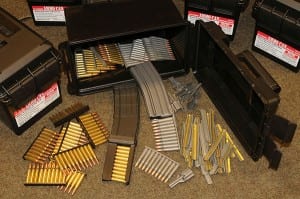
MTM ammo boxes, Thermold stripper clips and guide (l.) and GI strippers and guides (r.) are all handy for repacking .223 Rem/5.56 ammunition for storage or rapid access and easy loading.
Most riflemen will expend a good bit of effort when it comes to ammunition selection. Picking the right load whether for accuracy, performance or economy is important. The hardcore will often sweat blood over load selection. They will research tirelessly in their quest for the Holy Grail.
There’s nothing wrong with that, but what do you do with your load of choice once you have it? By this I mean, do you simply toss it on a shelf in its factory packaging? Do you give any thought at all to how you store it? Rather than leaving it as it comes, you may wish to repack it.
Why repack your ammunition? There are several good reasons. The factory cardboard boxes are designed to basically do two things: Catch your attention and turn your head with a bit of sex appeal on the dealer’s shelf; and to protect the ammunition from scratches and dents during shipping. If you want more than this, you’ll want to consider putting in a bit of time doing a repack.
Repacking better protects ammo from the elements, makes it more accessible and easier to load into magazines, and provides it with a longer storage life. The best part of repacking is there are a lot of options available to you.
While I don’t repack all my ammunition, I do repack training ammo I will use in the short term to get rid of the packing materials and to make the cartridges more accessible. With some brands of economical steel-case ammunition in particular, such as Wolf, you can end up with a large amount of paper and cardboard. This can be a pain on the range, especially if it’s windy. Better to eliminate it at home than having it blowing around and litter your range.
Next I take the loose cartridges and simply fill and properly label an MTM .50 caliber ammo can. The MTM cans are lighter than the steel military cans because they’re made out of rugged polypropylene, and because of that, you don’t need to worry about them rusting either.
They come with a folding handle and feature a tongue and groove O-ring seal for water resistance. The MTMs also sport a dual-latching system with double-padlock tabs allowing you to lock them, and they stack. Inner dimensions are 5.8x11x7.2 inches, and there are sizes other than the .50 caliber. Prices start at $12. Toss in a LULA loading tool, and reloading magazines will be a snap on the range.
I load some of my practice ammo onto 10-round stripper clips, which facilitate rapid reloading of M16/AR-15 magazines. This not only reduces loading time, it’s especially nice in finger-numbing cold weather. If you are not familiar with stripper clips they are a very simple device dating back to the 19th century. Made from stamped metal, they are designed to hold a small amount of cartridges, usually five or 10, and are intended to be used to rapidly reload a magazine.
They’re simple to use. Just slide a stripper clip guide onto the rear of an AR magazine, slip a loaded stripper clip into the guide, place firm downward pressure onto the top round and push them vigorously off the clip and into the magazine. Repeat two more times and you will have a fully loaded 30-round magazine. Just be aware that a good bit of force is required.
Surplus M16 stripper clips are readily available both new and used. However, they vary greatly in price and can vary in condition if used. The best source I have found is Old Sarge’s Drop Zone, which offers packs of 50 clips for just $7. That’s enough to do 500 rounds. Or they have 12 packs of 50, enough for 6,000 rounds for $48. Don’t forget to order some guides while you are at it.
An interesting option to GI strippers is available from Thermold Magazines. It sells black nylon 10-round strippers that are actually easier to use than the GI models. While not surplus cheap, I actually prefer them. Plus they also function as an emergency fire starter. Basically they burn hot and long enough to be useful in an emergency. They are available from Cheaper than Dirt for $3 for 10 along with the required special guide ($9).
Another option is to use GI bandoleer kits to repackage your ammunition. These consist of a cloth bandoleer with four, five or seven pockets, cardboard pocket liners that hold two or three stripper clips, stripper clips and a guide. Bandoleers allow you to easily grab a fair amount of ammunition and go.
For long-term storage, GI steel .30 caliber, .50 caliber or SAW cans are the way to go. As long as their gaskets are intact and in good condition, these cans are totally waterproof and air-tight. Plus their robust construction allows them to survive rough handling and abuse.
But there are other options ranging from new paint cans to whatever you can imagine and have on hand. Ammunition can be placed boxed, loose or on strippers in resealable or hermetically sealed bags.
Or if you want to go all out, cartridges can be placed into an airtight container and topped off with oxygen absorbers and desiccant packs. Oxygen absorbers do what their name implies; they absorb free oxygen from the air around them and chemically bind it by oxidizing finely divided iron into iron oxide.
The desiccant packs absorb moisture from the air. The combination of low humidity and low oxygen levels will help to prevent your cartridges from degrading during long term storage. Whatever method you use I’d be interested in hearing about it. Drop me email at Rifles@imoutdoors.com and tell me how you package your ammunition for short- and long-term storage
This article was originally posted by David Fortier
Read more: http://www.rifleshootermag.com/2012/12/04/how-to-repack-and-store-your-ar-ammunition/#ixzz2JIl6v8Hv


